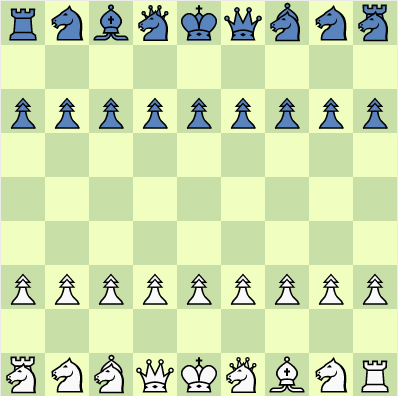
Mansindam (Pantheon tale)
Greetings, everyone! I am delighted to introduce a fascinating chess variant known as Mansindam (Pantheon tale). It is my pleasure to share this exciting game with you all today.This is a variant that combines the Shogi drop pieces rule with strong pieces and no draws.
PIECES:-
Every piece in this game gains the additional ability to be promoted as a non-royal king.
PAWN
When the pawn is promoted, it turns into a guard.
KNIGHT
It moves like a normal knight in traditional chess.
When promoted, it turns into a Centaur. It moves like a knight and a guard (promoted pawn)
BISHOP:-
it moves any number of squares diagonally. Just like in traditional chess. When promoted, it turns into an Archer.
The Archer moves like a bishop and a guard.
ROOK:-
It can move in any direction, either up, down, left or right, for any number of squares in a straight line. Promotes to a tiger.
The Tiger moves like a rook and a guard
CARDINAL:-
The cardinal moves like a bishop or knight. When promoted, it turns into a Rhino.
The rhino moves like a bishop, knight or guard.
MARSHAL:-
The Marshal moves like a rook or a knight. Promotes to a ship
The ship moves like a rook, knight or guard.
QUEEN:-
Moves like a rook or bishop just like in traditional chess.
ANGEL:-
It moves like a knight,rook or bishop.It does not promote.
KING:-
Moves one square orthogonally or diagonally. Does not promote.
We are finally done with the pieces. Now let us look at the rules:-
About king:-
When an opponent's pieces attack your king, it's called Check. If you cannot escape the check, it is called Checkmate, and you lose the game.
Basic rules:-
The player with Yang is considered as White, and the player with Eum is considered as Black. White always moves first, followed by Black. Players take turns to make their moves until one is defeated.
A player is not allowed to move a piece onto a square that is already occupied by a friendly piece. However, if a player moves a piece onto a square occupied by an enemy piece, then they capture that enemy piece and move onto that square.
Passing a turn is not allowed, and castling is not permitted.
About Promotion:-
the 7th, 8th, and 9th ranks are known as the Enemy camp. When a piece moves to, from, or within the enemy camp, it is promoted. Promotion is compulsory, which means that a piece that has the potential to be promoted must be promoted.
About Drops:-
any piece that you capture is known as a Handpiece. Such pieces are placed on a Piece stand, which is a square plate used to hold the captured pieces.
During your turn, you have the option to place a handpiece on any vacant square on the board instead of moving a piece that is already present on the board. This move is known as a Drop. However, you are only allowed to drop one piece per turn.
It's important to note that if you drop a piece in the enemy's camp, it will not be automatically promoted. This is because pieces are always dropped in their pre-promotion state. To promote a piece that is dropped in the enemy's camp, you must first move it after it has been dropped.
About Pawn Drop:-
Unlike in Shogi, you can deliver checkmate by dropping a Pawn.
Two or more of your own unpromoted Pawns cannot be placed on the same file. It is called Prohibition of Two Pawns.
Pawns cannot be dropped to the last (9th) rank.
About Defeat
Defeat is determined by the following cases.
When checkmate is delivered to you
When the opponent's King reaches the last rank
When you declared resignation
When you break one or more of all the rules above
When you break the rules of the tournament (e.g. time forfeit)
Hey! I hope you guys enjoyed my blog! Thank you! ![]()
